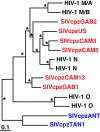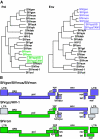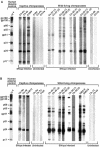Simian immunodeficiency virus infection of chimpanzees - PubMed (original) (raw)
Review
Simian immunodeficiency virus infection of chimpanzees
Paul M Sharp et al. J Virol. 2005 Apr.
Erratum in
- Correction for Sharp et al., "Simian Immunodeficiency Virus Infection of Chimpanzees".
Sharp PM, Shaw GM, Hahn BH. Sharp PM, et al. J Virol. 2022 Aug 10;96(15):e0045022. doi: 10.1128/jvi.00450-22. Epub 2022 Jul 25. J Virol. 2022. PMID: 35876514 Free PMC article. No abstract available.
No abstract available
Figures
FIG. 1.
Natural range of chimpanzee subspecies and location of SIVcpz isolation (adapted from reference 75). The locations of study sites in the Budongo Forest Reserve and Kibale National Park (Uganda), the Nyungwe Forest Reserve (Rwanda), Gombe and Mahale Mountains National Parks (Tanzania), and the Kisangani area (eastern Democratic Republic of Congo [DRC]) are indicated, as are the rescue locations of five previously reported SIVcpz-infected captive chimpanzees from southern Cameroon and northern Gabon (51). Asterisks indicate the presence of natural SIVcpz infection. The four recognized chimpanzee subspecies are color-coded. International borders (black lines) and major rivers (blue lines) are shown. Kinshasa, which marks the area where the greatest diversity of HIV-1 group M strains has been found (89), is also shown.
FIG. 2.
Evolutionary relationships of SIVcpz and HIV-1 strains based on maximum-likelihood phylogenetic analyses of full-length envelope protein sequences (adapted from ref. 10). SIVcpz strains from P. t. troglodytes and P. t. schweinfurthii are highlighted in red and blue, respectively. Representative strains of HIV-1 groups M, N, and O were included for comparison. Asterisks indicate internal branches with estimated posterior probabilities of 95% or higher. The scale bar denotes 10% replacements per site.
FIG. 3.
Phylogeography of SIVcpz (adapted from ref. 51). The phylogenetic relationships of available SIVcpz_Ptt_ (red) and SIVcpz_Pts_ (blue) strains are shown in a partial envelope region (180 amino acids). Brackets on the right indicate the country of origin of the various SIVcpz strains; SIVcpzUS and SIVcpzANT are of unknown geographic provenance.
FIG. 4.
Recombinant origin of SIVcpz. (A) Maximum-likelihood phylogenies of primate lentivirus Pol and Env sequences (adapted from ref. 9). The close genetic relationship of SIVcpz to SIVrcm from red-capped mangabeys in Pol, and to SIVgsn, SIVmus, and SIVmon from greater spot-nosed, mustached, and mona monkeys in Env, are highlighted in green and magenta, respectively. (B) Schematic diagram of the genomic organization of SIVcpz. Genomic regions are colored according to their genetic relationship to SIVrcm (green) or the SIVgsn/SIVmus/SIVmon lineage (magenta). Grey areas in SIVcpz are of unknown origin. Vpu and vpx genes are highlighted.
FIG. 5.
Chimpanzees hunt and eat other primates. An adult male chimpanzee from the Ngogo community (Kibale National Park, Uganda) feeds on the arm of a female red colobus monkey (photograph courtesy of John Mitani).
FIG. 6.
Detection of SIVcpz-specific antibodies in chimpanzee urine and fecal samples obtained by noninvasive methods. Urine (A) and fecal (B) specimens from captive and wild-living chimpanzees were tested by ECL Western immunoblot analysis for the presence of virus-specific antibodies. (Data for captive chimpanzees was adapted from Fig. 2 in reference .) Chimpanzees are identified by code number, with serial samples identified in parentheses. All wild-living chimpanzees are from Gombe National Park. Ch-37 and Ch-45 are members of the Mitumba community, and Ch-06, Ch-30, and Ch-22 are members of the Kasekela community. Fecal samples GM314 and GM316 are from unknown members of the nonhabituated Kalande community. Molecular weights of HIV-1-specific proteins are indicated. The banding patterns of plasma from an HIV-1-infected human (analyzed at a dilution of 1:10,000) is shown as a positive control.
Similar articles
- AIDS virus traced to chimp subspecies.
Cohen J. Cohen J. Science. 1999 Feb 5;283(5403):772-3. doi: 10.1126/science.283.5403.772. Science. 1999. PMID: 10049113 No abstract available. - Molecular screening for HIV-1 group N and simian immunodeficiency virus cpz-like virus infections in Cameroon.
Fonjungo PN, Dash BC, Mpoudi EN, Torimiro JN, Alemnji GA, Eno LT, Nkengasong J, Rayfield M, Folks TM, Pieniazek D, Lal RB. Fonjungo PN, et al. AIDS. 2000 Apr 14;14(6):750-2. doi: 10.1097/00002030-200004140-00018. AIDS. 2000. PMID: 10807202 No abstract available. - Origin of HIV-1 in the chimpanzee Pan troglodytes troglodytes.
Gao F, Bailes E, Robertson DL, Chen Y, Rodenburg CM, Michael SF, Cummins LB, Arthur LO, Peeters M, Shaw GM, Sharp PM, Hahn BH. Gao F, et al. Nature. 1999 Feb 4;397(6718):436-41. doi: 10.1038/17130. Nature. 1999. PMID: 9989410 - AIDS as a zoonosis: scientific and public health implications.
Hahn BH, Shaw GM, De Cock KM, Sharp PM. Hahn BH, et al. Science. 2000 Jan 28;287(5453):607-14. doi: 10.1126/science.287.5453.607. Science. 2000. PMID: 10649986 Review. - Origins of HIV and the AIDS pandemic.
Sharp PM, Hahn BH. Sharp PM, et al. Cold Spring Harb Perspect Med. 2011 Sep;1(1):a006841. doi: 10.1101/cshperspect.a006841. Cold Spring Harb Perspect Med. 2011. PMID: 22229120 Free PMC article. Review.
Cited by
- New strain of simian immunodeficiency virus identified in wild-born chimpanzees from central Africa.
Souquière S, Makuwa M, Sallé B, Kazanji M. Souquière S, et al. PLoS One. 2012;7(9):e44298. doi: 10.1371/journal.pone.0044298. Epub 2012 Sep 12. PLoS One. 2012. PMID: 22984489 Free PMC article. - Relative over-reactivity of human versus chimpanzee lymphocytes: implications for the human diseases associated with immune activation.
Soto PC, Stein LL, Hurtado-Ziola N, Hedrick SM, Varki A. Soto PC, et al. J Immunol. 2010 Apr 15;184(8):4185-95. doi: 10.4049/jimmunol.0903420. Epub 2010 Mar 15. J Immunol. 2010. PMID: 20231688 Free PMC article. - Loss of Siglec expression on T lymphocytes during human evolution.
Nguyen DH, Hurtado-Ziola N, Gagneux P, Varki A. Nguyen DH, et al. Proc Natl Acad Sci U S A. 2006 May 16;103(20):7765-70. doi: 10.1073/pnas.0510484103. Epub 2006 May 8. Proc Natl Acad Sci U S A. 2006. PMID: 16682635 Free PMC article. - A transitional endogenous lentivirus from the genome of a basal primate and implications for lentivirus evolution.
Gifford RJ, Katzourakis A, Tristem M, Pybus OG, Winters M, Shafer RW. Gifford RJ, et al. Proc Natl Acad Sci U S A. 2008 Dec 23;105(51):20362-7. doi: 10.1073/pnas.0807873105. Epub 2008 Dec 15. Proc Natl Acad Sci U S A. 2008. PMID: 19075221 Free PMC article. - What the COVID-19 Crisis Is Telling Humanity.
Wiebers DO, Feigin VL. Wiebers DO, et al. Neuroepidemiology. 2020;54(4):283-286. doi: 10.1159/000508654. Epub 2020 Jun 4. Neuroepidemiology. 2020. PMID: 32498068 Free PMC article. No abstract available.
References
- Ayouba, A., S. Souquieres, B. Njinku, P. M. Martin, M. C. Muller-Trutwin, P. Roques, F. Barre-Sinoussi, P. Mauclere, F. Simon, and E. Nerrienet. 2000. HIV-1 group N among HIV-1-seropositive individuals in Cameroon. AIDS 14:2623-2625. - PubMed
- Bailes, E., F. Gao, F. Bibollet-Ruche, V. Courgnaud, M. Peeters, P. A. Marx, B. H. Hahn, and P. M. Sharp. 2003. Hybrid origin of SIV in chimpanzees. Science 300:1713. - PubMed
- Bailes, E., R. R. Chaudhuri, M. L. Santiago, F. Bibollet-Ruche, B. H. Hahn, and P. M. Sharp. 2002. The evolution of primate lentiviruses and the origins of AIDS, p. 65-96. In T. A. Leitner (ed.), The molecular epidemiology of human viruses. Kluwer Academic Publishers, Boston, Mass.
Publication types
MeSH terms
Grants and funding
- R01 AI44596/AI/NIAID NIH HHS/United States
- N01 AI85338/AI/NIAID NIH HHS/United States
- R01 AI58715/AI/NIAID NIH HHS/United States
- R01 AI050529/AI/NIAID NIH HHS/United States
- R01 AI058715/AI/NIAID NIH HHS/United States
- N01AI85338/AI/NIAID NIH HHS/United States
- R01 AI044596/AI/NIAID NIH HHS/United States
- R01 AI50529/AI/NIAID NIH HHS/United States
LinkOut - more resources
Full Text Sources





